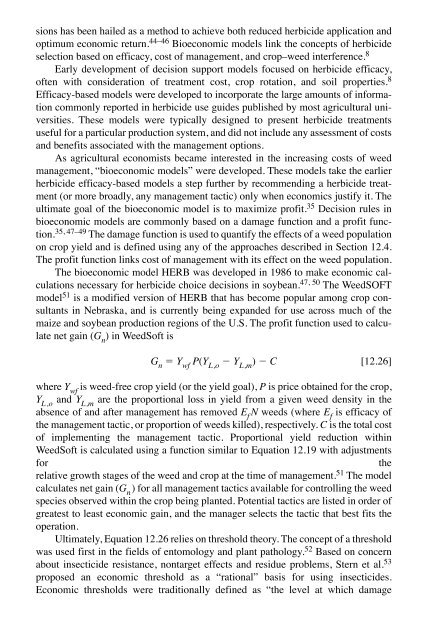Biotic Stress and Yield Loss
Biotic Stress and Yield Loss
Biotic Stress and Yield Loss
- No tags were found...
You also want an ePaper? Increase the reach of your titles
YUMPU automatically turns print PDFs into web optimized ePapers that Google loves.
sions has been hailed as a method to achieve both reduced herbicide application <strong>and</strong>optimum economic return. 44–46 Bioeconomic models link the concepts of herbicideselection based on efficacy, cost of management, <strong>and</strong> crop–weed interference. 8Early development of decision support models focused on herbicide efficacy,often with consideration of treatment cost, crop rotation, <strong>and</strong> soil properties. 8Efficacy-based models were developed to incorporate the large amounts of informationcommonly reported in herbicide use guides published by most agricultural universities.These models were typically designed to present herbicide treatmentsuseful for a particular production system, <strong>and</strong> did not include any assessment of costs<strong>and</strong> benefits associated with the management options.As agricultural economists became interested in the increasing costs of weedmanagement, “bioeconomic models” were developed. These models take the earlierherbicide efficacy-based models a step further by recommending a herbicide treatment(or more broadly, any management tactic) only when economics justify it. Theultimate goal of the bioeconomic model is to maximize profit. 35 Decision rules inbioeconomic models are commonly based on a damage function <strong>and</strong> a profit function.35, 47–49 The damage function is used to quantify the effects of a weed populationon crop yield <strong>and</strong> is defined using any of the approaches described in Section 12.4.The profit function links cost of management with its effect on the weed population.The bioeconomic model HERB was developed in 1986 to make economic calculationsnecessary for herbicide choice decisions in soybean. 47, 50 The WeedSOFTmodel 51 is a modified version of HERB that has become popular among crop consultantsin Nebraska, <strong>and</strong> is currently being exp<strong>and</strong>ed for use across much of themaize <strong>and</strong> soybean production regions of the U.S. The profit function used to calculatenet gain (G n) in WeedSoft isG n Y wfP(Y L,o Y L,m) C [12.26]where Y wfis weed-free crop yield (or the yield goal), P is price obtained for the crop,Y L,o<strong>and</strong> Y L,mare the proportional loss in yield from a given weed density in theabsence of <strong>and</strong> after management has removed E fN weeds (where E fis efficacy ofthe management tactic, or proportion of weeds killed), respectively. C is the total costof implementing the management tactic. Proportional yield reduction withinWeedSoft is calculated using a function similar to Equation 12.19 with adjustmentsfortherelative growth stages of the weed <strong>and</strong> crop at the time of management. 51 The modelcalculates net gain (G n) for all management tactics available for controlling the weedspecies observed within the crop being planted. Potential tactics are listed in order ofgreatest to least economic gain, <strong>and</strong> the manager selects the tactic that best fits theoperation.Ultimately, Equation 12.26 relies on threshold theory. The concept of a thresholdwas used first in the fields of entomology <strong>and</strong> plant pathology. 52 Based on concernabout insecticide resistance, nontarget effects <strong>and</strong> residue problems, Stern et al. 53proposed an economic threshold as a “rational” basis for using insecticides.Economic thresholds were traditionally defined as “the level at which damage

















